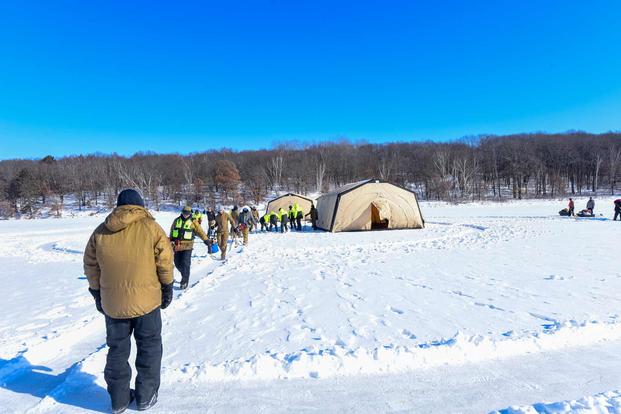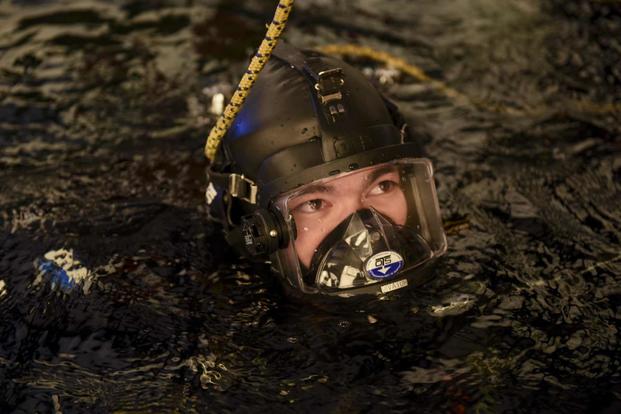The Coast Guard's Cold Water Ice Diving (CWID) joint-service course will now occur in the Arctic environment of Camp Ripley, Minnesota.
"Because if you can operate in Minnesota in the dead of winter — you can operate anywhere," said Chief Warrant Officer Sean Eversole, a Coast Guard instructor, regarding the high-risk training held at the National Guard facility for the first time earlier this year.

Though the Department of Defense recently emphasized its Arctic Strategy because of threats from Russia and China, CWID exercises are not new for the military.
CWID has occurred for decades among the service branches, but when a fatal accident involving two divers occurred in 2006, the Coast Guard took charge of the training, explained Coast Guard Petty Officer 1st Class Joshua Bredesen, lead CWID instructor.
Not only has the Coast Guard trained divers since World War II, but divers have also honed their CWID skills for rescue missions and defending America's borders in the most severe conditions. In addition, they protect maritime environments in extreme climates, like supporting summer rotations to the McMurdo Station, a research station in Antarctica.
At first, bases in Seattle, Washington, and British Columbia hosted CWID, but the COVID-19 pandemic forced the divers to look elsewhere. Camp Ripley met the criteria. In fact, the Minnesota grounds proved so ideal, they will now continue to host CWID, Eversole and Bredesen both said.
The instructors also explained that because many divers are stationed in warmer climates, such as the USCG Special Missions Training Center at Camp Lejeune, North Carolina, or the Naval Diving and Salvage Training Center in Panama City, Florida, CWID training is a necessity for preparedness.
The 12 Coast Guardsmen, two Navy divers and two Army divers participating this year also followed "a crawl, walk, run" approach to allow for acclimation, according to Bredesen.
First, divers familiarized themselves with equipment outfitted for the extreme temperatures and practiced emergency procedures in a controlled dive tank near the facility at the Minnesota School of Diving Inc. in Brainerd.
Next, students went on to Ripley's frozen Ferrell Lake, where they learned to assess ice thickness, determine if it's safe to work on and cut entry and exit holes.
![U.S. Coast Guard Chief Petty Officer Christopher Tull [left] inspects the holes in the dive site before students make their cuts on Lake Ferrell, Minn., Feb. 2, 2022. (U.S. Coast Guard Photo by Petty Officer 3rd Class Gregory Schell) Coast Guardsman inspects an ice hole before ice dive training.](http://images03.military.com/sites/default/files/styles/full/public/2022-05/mil-coast-guard-ice-diving-course-inspection-1800.jpg?itok=yjt-wf0u)
Divers then set up tents as they operated in and out of 35-degree water with air temperatures dipping below 40 degrees with wind chills. Even with temperatures above freezing in the enclosed space, the team had to clear ice from the entry and exit holes every hour.
After equipment divers double–checked equipment for safety, they submerged for 20 minutes at a time so they could adapt to maneuvering under the ice in multiple layers.
In subsequent dives, students advanced to performing tasks that tested dexterity and fine motor skills, such as using wrenches to remove nuts from bolts before egressing through an emergency hole, with the high risk of becoming lost under the ice and murky waters.
Coast Guard Petty Officer 2nd Class Casey Connors, a student, detailed the experience. He described dressing in a layering system including thermal wear, wool socks, beanies and gloves before getting into a dry suit and scuba gear, creating the tightest sealing system possible.
Connor explained what it was like being squeezed by the change of pressure when submerged underwater in the frigid lake.
"It's scary and beautiful at the same time," he said, especially "when diving under the ice in Minnesota, knowing there's 15 inches of ice above you … the view is like looking through a glass from underwater."
He reiterated that equipment is more prone to failure in extreme temperatures, including when they experienced an 80-degree change from one day to the next during the course.
But CWID training teaches students "how to deal with potential failures and how not to panic," he stated, and the "point of the course is to also build divers' confidence."
Connor also emphasized that despite the inherent dangers of diving and participating in hazardous training, everyone wants the opportunity to dive.
"Even if it doesn't sound like the greatest job, everyone raises their hand," he said.
The reason being, the camaraderie between the tight–knit group of 60 divers makes "being part of the Coast Guard dive family one of the greatest jobs you can get in this world," he added.
Elizabeth Aslakson is a freelance writer whose work revolves around military issues as well as her own Army wife adventures and love of history.
Read the original article on MilitaryFamilies.com













